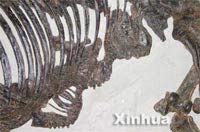 Archaeologists in Shandong Province, China, have recently unearthed the fossil of a hornless rhinoceros that was pregnant with a fetus, dating back 18 million years.
Archaeologists in Shandong Province, China, have recently unearthed the fossil of a hornless rhinoceros that was pregnant with a fetus, dating back 18 million years.
The fossil was discovered during excavations at the Shanwang site, which preserves remnants of ancient life, located 22 kilometers northeast of Linqu County in Shandong. Shanwang is the only well-preserved archaeological site from the Miocene epoch (25-13 million years ago) in eastern China.
The rhinoceros measured 2.7 meters in length and stood 1.7 meters tall, and it is remarkably intact. The fetus inside was only 0.7 meters long, with developed teeth and bones that were nearly complete.
Experts believe the animal died eight months before giving birth, according to Li Fenglin, a professor at China University of Geosciences. “It is extremely rare to discover a fossil of a pregnant rhinoceros like this.”
The hornless rhinoceros is an ancestor of modern rhinoceros species. This type of rhinoceros had short limbs, with three toes on each foot, and thick skin similar to armor. They typically gave birth to one offspring after a gestation period of 15-18 months.
The Shanwang area once experienced volcanic activity during the third era (Cenozoic), approximately 20 million years ago. The rhinoceros could have fallen victim to a volcanic eruption.
Li and his team also discovered other fossils, including those of deer, spiders, and scorpions. In total, they have identified 700 species of flora and fauna at this site.
M.T. (according to Xinhua News Agency)




















































